This article was co-authored by Lee-Hsin Fang, DPM. Dr. Fang is a licensed Foot and Ankle Surgeon with his own medical practice in Mountain View, California. He received his Doctorate degree from California College of Podiatric Medicine in San Francisco, California and completed his residency at the California College of Podiatric Medicine in 1999.
There are 18 references cited in this article, which can be found at the bottom of the page.
wikiHow marks an article as reader-approved once it receives enough positive feedback. In this case, 80% of readers who voted found the article helpful, earning it our reader-approved status.
This article has been viewed 174,089 times.
A broken bone or fracture in a foot is usually accompanied by tremendous pain or even with a snapping sound. There are 26 bones in each foot and each ankle joint has 3 bones. Some people have extra sesamoid bones in their feet, too. As the foot takes much pounding every day, breaks and fractures are quite common. Properly diagnosing and treating a broken foot is extremely important to the healing process and should be done with care.[1]
Steps
Getting Emergency Treatment for a Broken Foot
-
1Move the patient to a safe location and check for other injuries. If the patient has also suffered a head, neck, or back injury, move him as little as possible and be extremely careful when doing so. Both the safety of the patient and the rescuer are more important than the immediate diagnosis and treatment of the foot injury.[2]
-
2Remove the shoes and socks of both feet and check for common symptoms of a broken foot. Compare both feet side by side to check for swelling or any other differences in appearance. The most common symptoms are immediate pain, swelling, and deformity. Other symptoms include:[3]
- Bruising or tenderness of the foot.
- Numbness, coldness, or bruising.
- Large wounds or exposed bones.
- Increased pain when active, and decreased pain with rest.
- Difficulty walking or bearing weight.
Advertisement -
3Control any bleeding. Apply pressure to the wound, using gauze if possible. If the gauze pad or cloth becomes soaked with blood, do not remove it. Add another layer and continue applying pressure. [4]
-
4Call for an ambulance if the patient is in extreme pain, or if the foot exhibits any major symptoms. Some major symptoms are misshapenness, deformity, large cuts or wounds, and severe discoloration of the foot. While the ambulance is on its way, encourage the patient to keep still and stay calm. Keep the patient lying down, with the injured foot elevated higher than the heart.[5]
-
5Splint the injured foot if it is not possible to get an ambulance. Immobilize the foot by placing a stick or rolled up newspaper along the inside of the foot from the heel to the big toe and pad it with a cloth. Wrap a belt or another piece of cloth around the splinted foot to secure the splint. If no splint is available, wrap a rolled-up towel or pillow around the foot and tape or tie it on with a bandage. Remember the ultimate goal is to limit motion. Tie the splint or wrap reasonably tightly, but not so tight that circulation is restricted.[6]
-
6Ice the injury and continue to elevate the foot to reduce swelling. Put a towel or a sheet between the skin and the ice. Leave the ice on for 15 minutes and then remove it for 15 minutes. The patient should not walk on the injured foot if putting weight on it is painful.[7]
- If you have crutches around, use them.
Recognizing Stress Fractures of the Foot
-
1Recognize your risk factors. Stress fractures are fairly common injuries to the foot and ankle. They're especially common in athletes, because they often result from overuse and repetitive stresses, such as those that long-distance runners endure.[8]
- Sudden increases in activity can also cause stress fractures. For example, if you're usually fairly sedentary but take a hiking holiday, you might end up with a stress fracture.
- Osteoporosis and certain other conditions that affect bone strength and density make you more prone to stress fractures.
- Trying to do too much too soon can cause stress fractures. For example, if you're new to exercise and start trying to run a 10k every week, you could end up with a stress fracture.
-
2Watch out for pain. If you feel pain in your foot or ankle that eases when you rest, you may have a stress fracture. If the pain gets worse during normal everyday activities, it's a good sign you have a stress fracture. The pain will also get worse over time.[9]
- The pain may feel deep inside your foot, toe, or ankle.
- Pain isn't just weakness leaving your body. If you experience consistent foot pain, especially if it's even during everyday activities or persists when you rest, see your doctor. Ignoring it could lead to worse injury.
-
3Look for swelling and tenderness. If you have a stress fracture, you may notice that the top of your foot is swollen and tender to the touch. Swelling may also occur on the outside of the ankle.[10]
- Sharp pain when you touch an area of your foot or ankle isn't normal. If you experience pain or tenderness when you touch your foot, see your doctor.
-
4Examine the area for bruising. Bruises don't always occur with stress fractures, but they can.[11]
-
5See a doctor. You may be tempted to "tough it out" with the pain from a stress fracture, but don't. If you do not seek treatment for a stress fracture, it can get worse over time. The bone may even break completely.[12]
Follow-Up Care for a Broken Foot
-
1Trust your doctor's diagnosis. Depending on the symptoms, the doctor may need to run a few non-invasive imaging tests on the injured foot. The most common tests are x-rays, CT (Computerized Tomography) scans, and MRIs (Magnetic Resonance Imaging). These techniques allow the doctor to examine the foot for broken bones and monitor the bones as they heal.[13]
-
2Follow your doctor's advice for follow-up treatment. In many cases, surgery is not necessary for proper treatment of a broken foot. Often the hospital will put the foot in a hard cast and/or provide crutches to keep the weight off the foot. The doctor will likely advise you to keep the foot elevated and ice the injury to prevent swelling and re-injury.[14]
- When using crutches, put your weight on your arms and hands. Do not put all your weight on your armpits, which could hurt the nerves that are in your underarms.
- Follow your doctor's orders! Failure to comply with keeping your weight off the foot is the number one cause of delayed healing and re-injury for fractures.
-
3Take any medication as prescribed. You may be advised to take over-the-counter NSAIDs (Nonsteroidal Anti-Inflamatory Drugs) such as aspirin, ibuprofen (Advil, Motrin) or naproxen (Aleve). These will help reduce the pain and swelling associated with the healing process.[15]
- If you are scheduled to undergo surgery you may need to stop taking medication a week before the surgery takes place. Consult with your doctor or surgeon.[16]
- Take the smallest dose possible to manage your pain. Stop taking NSAIDs after 10 days to avoid complications.
- Your doctor may also recommend upping your consumption of calcium and vitamin D, which are both crucial for bone health.[17]
-
4Undergo surgery, if recommended by your doctor. For most foot injuries, your doctor will try to give your foot time to heal itself by putting on a cast and limiting your activity. In some cases, though, your injured foot may need a manipulation (known as an ORIF, or open reduction internal fixation) if the broken ends of the bone are misaligned. This involves the movement of the bone into the proper alignment, after which pins are passed through the skin to hold the bone in place while it heals. The healing process for a reduction takes an average of 6 weeks, after which the pins are easily removed. In more severe cases you may need surgery to implant screws or rods to keep the foot in position while it heals.[18]
-
5Follow up with an orthopedic doctor or podiatric surgeon. Even if your injury doesn't require surgery, an orthopedic doctor or podiatric surgeon will be able to monitor the healing process. In the event of re-injury or other impairments to the healing process, the doctor will prescribe the appropriate treatment, therapy, or surgery.
Physical Therapy for a Broken Foot
-
1Go to physical therapy after the cast is removed, as advised by your doctor. You can learn exercises to improve the strength and flexibility in your injured foot and help prevent further injury.[19]
-
2Warm up at the beginning of each session. Start with a few minutes of light exercise, such as walking or riding a stationary bike. This will loosen your muscles and get blood flowing.[20]
-
3Stretch. Stretching exercises are a key step to restoring flexibility and range of motion. Following your doctor or therapist's recommended exercises, stretch the muscles and tendons in the injured foot. If you feel any pain during stretching, consult your doctor.[21]
- A good example of a stretch is the towel stretch. Sitting on the floor with one leg straightened, loop a towel around the ball of your foot. Hold on to the ends of the towel and pull the top of your foot towards you. You should feel the stretch in your calf and down into the heel. Hold the stretch for 30 seconds, and then rest for 30 seconds. Repeat the exercise 3 times.[22]
-
4Perform the appropriate strengthening exercises. When done properly, strength exercises should help return the strength and endurance required for everyday activities to the injured foot. If you experience any pain during these exercises, consult your physical therapist or doctor.[23]
- An example of a strength exercise is the marble pickup. Sit in a chair with both feet flat on the ground and put 20 marbles on the ground in front of you. Place a bowl near the marbles. Pick up the marbles one by one with your injured foot and place them into the bowl. You should feel the exercise on the top of your foot.
-
5Regularly perform the prescribed exercises. It is important to keep up with your physical therapy to help you return to daily activities and reduce your chances of re-injury.[24]
References
- ↑ https://www.apma.org/Patients/FootHealth.cfm?ItemNumber=982
- ↑ https://www.redcross.org/take-a-class/first-aid/performing-first-aid/first-aid-steps
- ↑ https://www.apma.org/Patients/FootHealth.cfm?ItemNumber=982
- ↑ https://medlineplus.gov/ency/article/000045.htm
- ↑ https://www.redcross.org/take-a-class/first-aid/performing-first-aid/first-aid-steps
- ↑ https://medlineplus.gov/ency/article/000001.htm
- ↑ https://www.rch.org.au/kidsinfo/fact_sheets/Fractures_broken_bones/
- ↑ https://my.clevelandclinic.org/health/diseases/15841-stress-fractures
- ↑ https://my.clevelandclinic.org/health/diseases/15841-stress-fractures
- ↑ https://kidshealth.org/en/teens/stress-fractures.html
- ↑ https://patient.info/foot-care/heel-and-foot-pain-plantar-fasciitis/metatarsal-fractures
- ↑ https://kidshealth.org/en/teens/stress-fractures.html
- ↑ https://patient.info/foot-care/heel-and-foot-pain-plantar-fasciitis/metatarsal-fractures
- ↑ https://www.healthychildren.org/English/health-issues/injuries-emergencies/Pages/Children-And-Broken-Bones.aspx
- ↑ https://myhealth.alberta.ca/Health/aftercareinformation/pages/conditions.aspx?hwid=uf7718
- ↑ https://www.uclahealth.org/anes/which-medications-should-i-take
- ↑ https://www.bones.nih.gov/health-info/bone/bone-health/nutrition/calcium-and-vitamin-d-important-every-age
- ↑ https://www.footcaremd.org/conditions-treatments/midfoot/foot-fracture-surgery
- ↑ https://www.ncbi.nlm.nih.gov/books/NBK554538/
- ↑ http://orthoinfo.aaos.org/PDFs/Rehab_Foot_and_Ankle_4.pdf
- ↑ https://www.ruh.nhs.uk/patients/patient_information/ORT050_Advice_after_a_foot_fracture.pdf
- ↑ https://orthoinfo.aaos.org/globalassets/pdfs/2017-rehab_foot-and-ankle.pdf
- ↑ http://orthoinfo.aaos.org/PDFs/Rehab_Foot_and_Ankle_4.pdf
- ↑ https://www.ruh.nhs.uk/patients/patient_information/ORT050_Advice_after_a_foot_fracture.pdf
About This Article
If you think you might have a broken foot, take off your shoes and socks and compare both of your feet to see if the injured foot looks discolored, misshapen, or swollen compared to the healthy foot. Notice if there is any pain, bruising, numbness, or skin that feels cold to the touch. If your foot is bleeding, apply pressure to the wound by wrapping it tightly in gauze or cloth. Call for emergency medical services, and lie down with your injured foot elevated above your heart while you wait for the ambulance to arrive. For more tips from our Medical co-author, like how to splint an injured foot, keep reading!

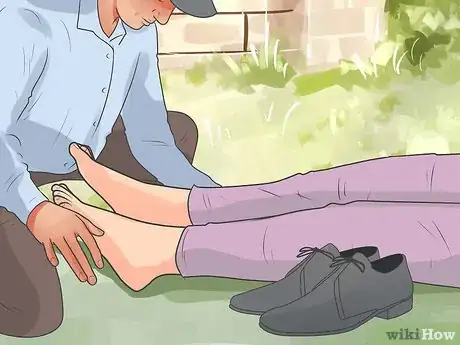
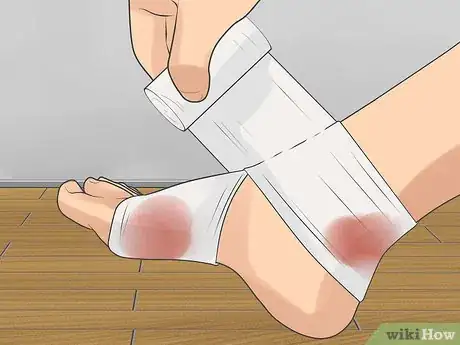

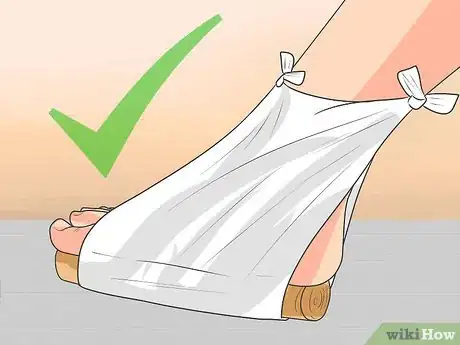

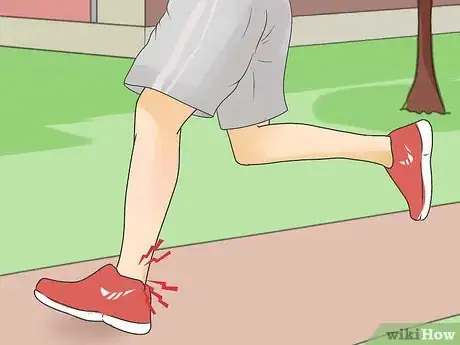
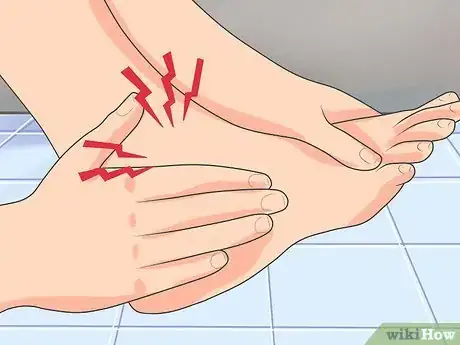




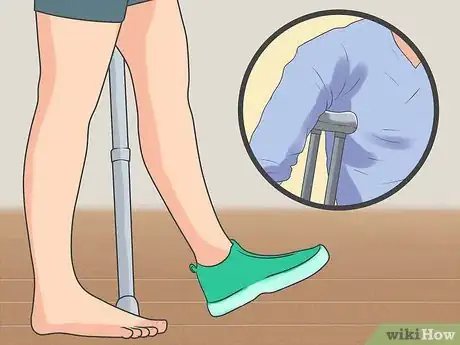


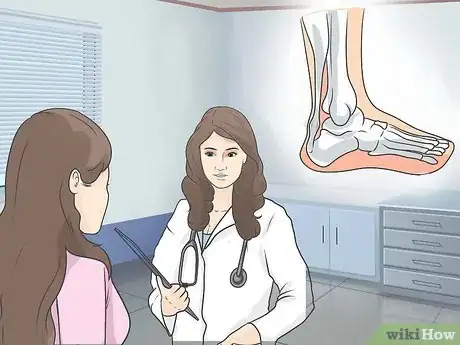

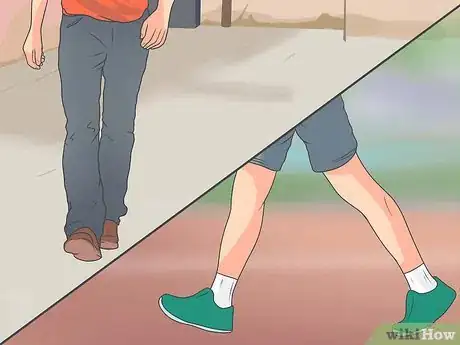

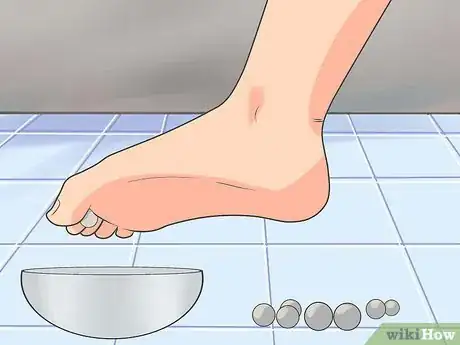

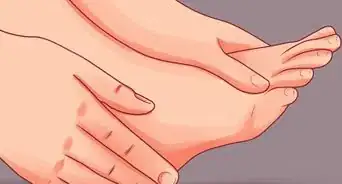


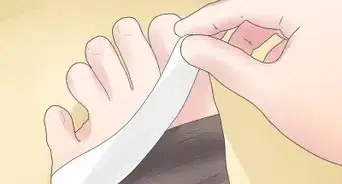
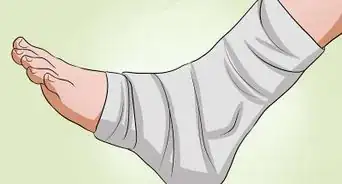
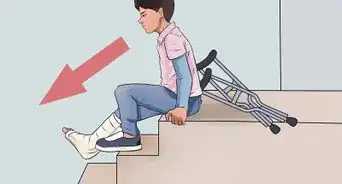
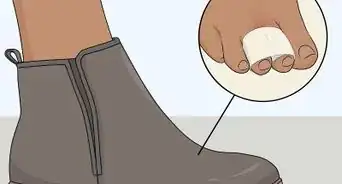





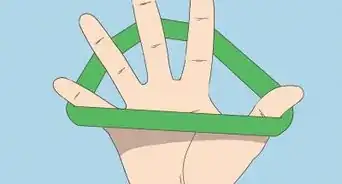










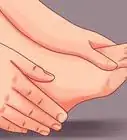


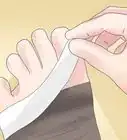



































Medical Disclaimer
The content of this article is not intended to be a substitute for professional medical advice, examination, diagnosis, or treatment. You should always contact your doctor or other qualified healthcare professional before starting, changing, or stopping any kind of health treatment.
Read More...